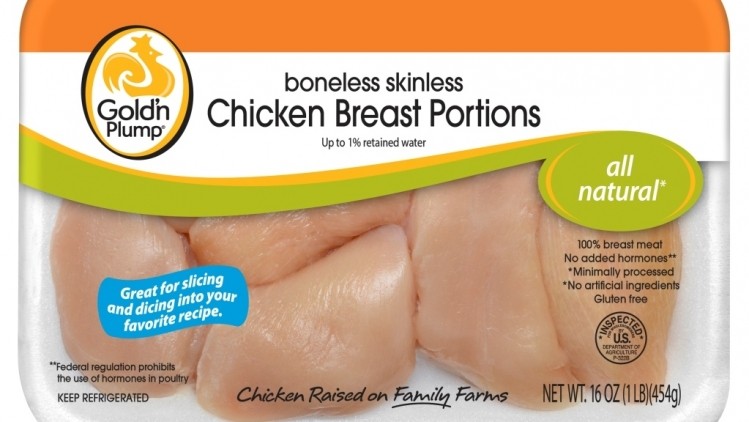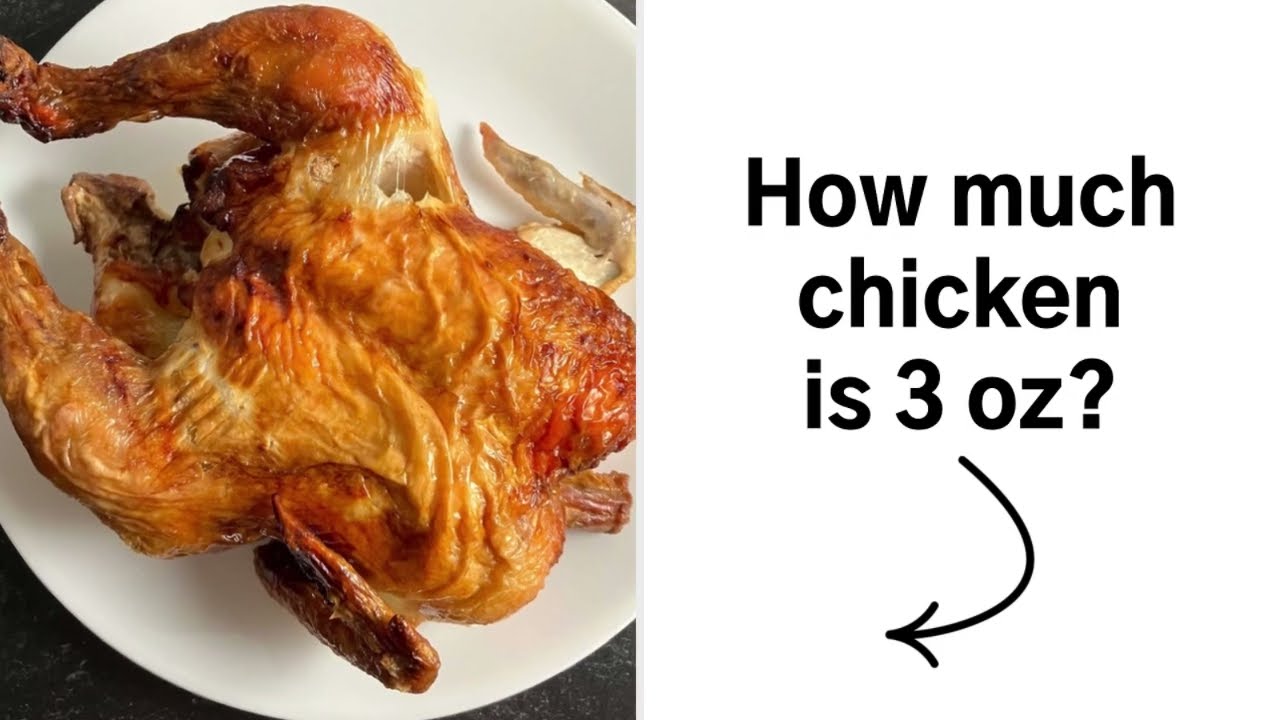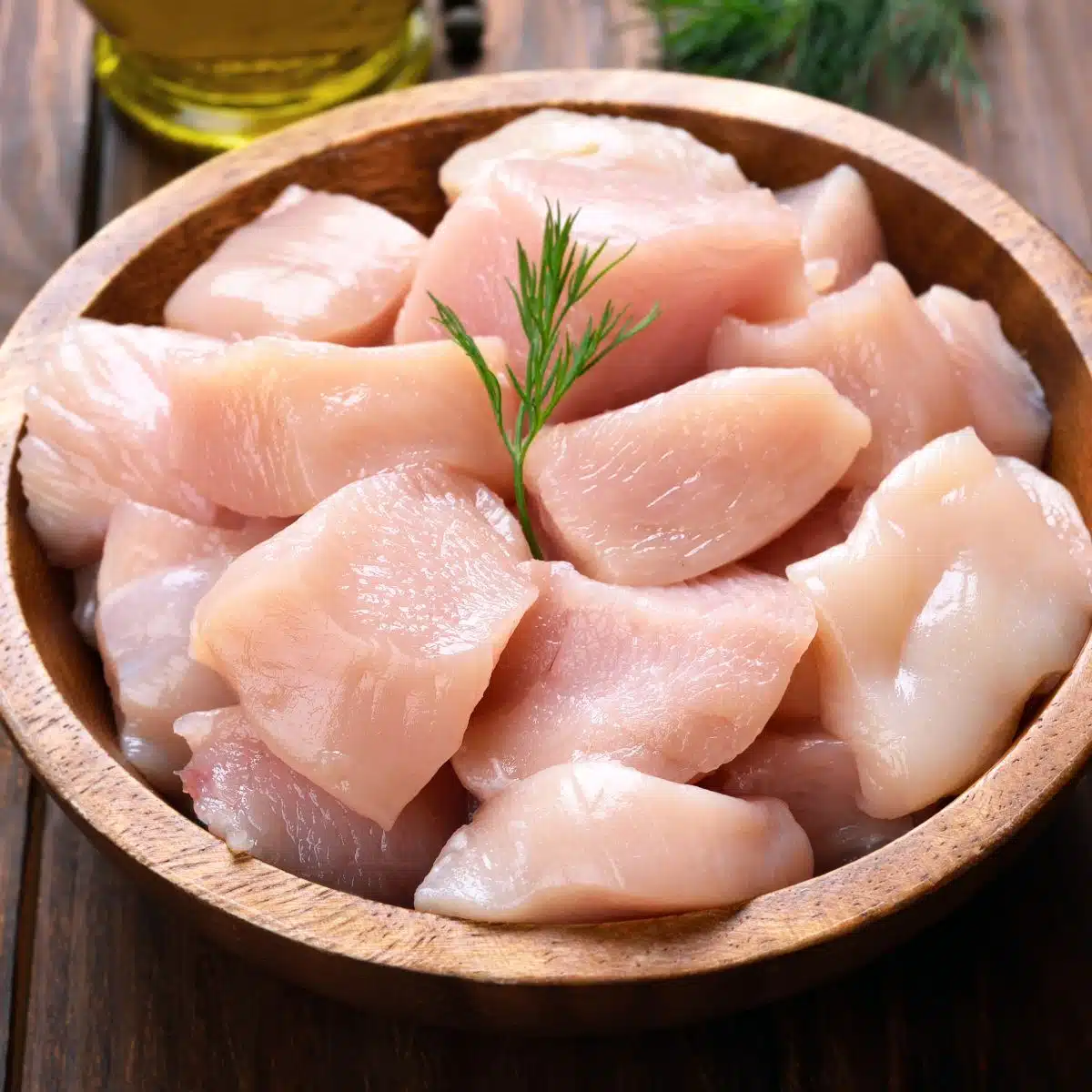
Introduction
Understanding Portion Sizes And Dietary Guidelines
Portion control plays a crucial role in maintaining a healthy diet. Knowing the appropriate serving size of different foods, including chicken, is important for achieving a well-balanced meal. According to dietary guidelines, a serving size of cooked chicken is typically around 3 ounces. However, many people find it challenging to estimate this amount accurately.
Importance Of Accurately Measuring 3 Ounces Of Chicken
Accurately measuring 3 ounces of chicken is essential for portion control and maintaining a healthy calorie intake. Consuming larger portions can lead to overeating, which can contribute to weight gain and other health issues. On the other hand, having smaller portions may not provide enough nutrients for the body.
To ensure you’re getting the right amount of chicken, it’s useful to know how to estimate 3 ounces using common household objects. There are a couple of simple methods you can try if you don’t have access to a kitchen scale.
- Comparing to everyday objects: One way to estimate 3 ounces of chicken is by comparing it to everyday objects. For example, 3 ounces is roughly the size of a deck of cards or the palm of your hand.
- Using a food diary or portion control plate: Another method is to use a food diary or a portion control plate. These tools often have guidelines that show the appropriate portion sizes for different food groups, including chicken.
While these methods may not be as accurate as using a kitchen scale, they can help provide a rough estimate to ensure you’re staying within the recommended portion size of 3 ounces of chicken.
Remember, portion control is key to maintaining a healthy lifestyle. By measuring your food accurately, such as 3 ounces of chicken, you can support your overall well-being and make informed choices for your meals.
Using A Kitchen Scale
Benefits Of Using A Kitchen Scale
Using a kitchen scale is the simplest and most accurate method to measure 3 ounces of chicken. Here are a few benefits of using a kitchen scale:- Precision: A kitchen scale provides an exact measurement, ensuring you’re consuming the recommended serving size of chicken.- Consistency: By consistently weighing your portions with a scale, you can maintain portion control and better track your calorie intake.- Versatility: Kitchen scales can be used to measure other ingredients as well, making them a useful tool in the kitchen.
Step-by-step Guide On Weighing 3 Ounces Of Chicken
Here’s a step-by-step guide on how to weigh 3 ounces of chicken using a kitchen scale:1. Place a clean plate or container on the scale and press the tare or zero button to reset the weight to zero.2. Take your chicken and place it on the plate or container on the scale.3. Read the display on the scale to see the weight of the chicken in ounces.4. Remove or add chicken as needed to reach the desired weight of 3 ounces.5. Once you have achieved the correct weight, use the chicken as desired in your recipe or meal.
Using a kitchen scale ensures accuracy in measuring 3 ounces of chicken, allowing you to maintain portion control and support your overall health goals.
Estimating 3 Ounces Of Chicken
Benefits Of Using A Kitchen Scale
Using a kitchen scale is the simplest and most accurate method to measure 3 ounces of chicken. Here are a few benefits of using a kitchen scale:- Precision: A kitchen scale provides an exact measurement, ensuring individuals consume the recommended serving size of chicken.- Consistency: By consistently weighing portions with a scale, individuals can maintain portion control and better track their calorie intake.- Versatility: Kitchen scales can also be used to measure other ingredients, making them a useful tool in the kitchen.
Step-by-step Guide On Weighing 3 Ounces Of Chicken
Here’s a step-by-step guide on how to weigh 3 ounces of chicken using a kitchen scale:1. Place a clean plate or container on the scale and press the tare or zero button to reset the weight to zero.2. Take the chicken and place it on the plate or container on the scale.3. Read the display on the scale to see the weight of the chicken in ounces.4. Remove or add chicken as needed to reach the desired weight of 3 ounces.5. Once the correct weight is achieved, use the chicken as desired in a recipe or meal.
Popular Household Items For Estimation
If a kitchen scale is not available, there are alternative methods for estimating a 3-ounce portion of chicken:- Visual estimation: Use the size comparisons mentioned earlier to estimate the portion size visually.- Compare to known objects: If unsure, compare the chicken to common household objects. For example, a deck of cards is roughly the size of a 3-ounce portion of chicken.
Tips For Accurate Estimation Without A Scale
To improve accuracy when estimating without a scale, consider these tips:- Practice: Over time, practice can help individuals become more accurate in visually estimating portion sizes.- Use reference guides: Look up portion size references for different foods to have a better understanding of what a 3-ounce portion should look like.- Seek professional guidance: Consult a nutritionist or dietitian to receive guidance on portion sizes and estimation methods.
Estimating 3 ounces of chicken without a kitchen scale is possible with practice and comparison to known objects. However, for precise and consistent measurements, using a kitchen scale is recommended.
Comparison Guide: What Does 3 Ounces Of Chicken Look Like?
Visual Reference For 3 Ounces Of Chicken
To visually estimate a 3-ounce portion of chicken, you can use the following references:- A deck of cards is roughly the size of a 3-ounce portion of chicken.- The palm of your hand, excluding the fingers, is also a good reference. 3 ounces of chicken should fit in the palm of an adult’s hand.- A smartphone or the size of your fist can also give you an idea of the size of a 3-ounce portion.
Comparing Different Cuts And Cooking Methods
The weight of 3 ounces of chicken remains the same regardless of the cut or cooking method. However, it is important to note that the volume and appearance may vary. Here are some comparisons for common chicken cuts and cooking methods:- Skinless, boneless chicken breast: A 3-ounce portion is about the size of a deck of cards.- Skinless, boneless chicken thigh: A 3-ounce portion is slightly smaller than a deck of cards.- Chicken drumstick: A single drumstick typically weighs around 4 ounces, so 3 ounces would be slightly smaller.- Grilled chicken: Grilling tends to shrink the meat, so a 3-ounce portion may appear smaller after cooking compared to raw chicken.
Remember, these are estimates and may vary depending on the size and thickness of the chicken pieces. Using a kitchen scale is still the most accurate method for measuring 3 ounces of chicken.

Alternative Measurement Methods
Using Measuring Cups And Spoons
If you don’t have a food scale, you can use measuring cups and spoons as an alternative method to measure a 3-ounce portion of chicken. Here are some conversions you can use:- 1/2 cup of cooked chicken is approximately 3 ounces.- 3 tablespoons of cooked chicken is approximately 1 ounce.Keep in mind that these measurements are approximate and may vary depending on the density and moisture content of the chicken.
Applying Common Visual Cues For Portion Control
In addition to using comparisons and references, you can also apply some common visual cues to estimate a 3-ounce portion of chicken:- A 3-ounce portion is roughly the size of a palm of an adult’s hand, excluding the fingers.- It is also equivalent to the size of a deck of cards or the size of your fist.Keep in mind that these visual cues are not as precise as using a food scale, but they can still provide a helpful guideline for portion control.
Remember, while these alternative methods can be convenient, it’s important to note that using a kitchen scale is still the most accurate way to measure a 3-ounce portion of chicken.
Adjusting Recipes And Portion Sizes
When it comes to cooking with chicken and portion control, it’s important to adjust recipes and portion sizes accordingly. Here are a few tips to help you with this:
Converting Recipes To Ensure Correct Chicken Portions
- If a recipe calls for a certain amount of chicken, such as 8 ounces, you can easily convert it to a 3-ounce portion by dividing the amount by 8 and then multiplying it by 3.- For example, if a recipe calls for 8 ounces of chicken, divide 8 by 8 (which equals 1), and then multiply it by 3. This means you would need 3 ounces of chicken for the recipe.
Tips For Portion Control When Eating Out
- When dining out, it can be challenging to control portion sizes. However, there are a few strategies you can try: – Share a meal with someone else to reduce the amount of chicken you consume. – Ask for a to-go box at the beginning of the meal and portion out a suitable amount of chicken before you start eating. – Look for menu options that offer smaller portion sizes or order an appetizer-sized portion of chicken.
Remember, properly measuring and portioning your chicken is essential for both your health and culinary success. Use a scale whenever possible for the most accurate results.
The Dangers Of Overeating Or Underestimating Portions
Impact On Calorie Intake And Weight Management
Consuming larger portions of chicken can significantly increase your calorie intake. For example, if you eat double the recommended 3-ounce serving size, you would be consuming 256 calories instead of the intended 128. This can lead to weight gain and make it more challenging to manage your overall calorie intake.
On the other hand, underestimating portions may result in inadequate energy intake. If you consistently consume less chicken than recommended, you may not be getting enough protein and essential nutrients needed for optimal health and functioning.
Risks Of Foodborne Illnesses Due To Undercooked Chicken
Undercooked chicken can pose serious risks to your health. It can contain harmful bacteria like salmonella, which can cause foodborne illnesses. Accurately measuring and cooking chicken to the recommended internal temperature of 165°F (75°C) is crucial to ensure the elimination of any harmful pathogens.
It’s important to be aware of the potential dangers of overeating or underestimating chicken portions. By understanding and properly measuring your chicken servings, you can maintain a balanced diet, manage your weight effectively, and reduce the risk of foodborne illnesses. Remember to always follow food safety guidelines when handling and cooking chicken.

Tips For Chicken Preparation And Storage
Safe Handling Practices For Chicken
It is important to follow safe handling practices when preparing chicken to ensure food safety and prevent foodborne illnesses. Here are some tips to keep in mind:
- Always wash your hands thoroughly with soap and water before and after handling raw chicken.
- Use separate cutting boards and utensils for raw chicken to avoid cross-contamination with other foods.
- Thoroughly clean and sanitize any surfaces that come into contact with raw chicken.
- Avoid rinsing raw chicken before cooking, as this can spread bacteria through water splashes.
- Cook chicken to the recommended internal temperature of 165°F (75°C) to ensure all harmful bacteria are killed.
- Refrigerate or freeze chicken promptly after purchase or preparation to prevent bacteria growth.
Proper Storage To Maintain Freshness And Minimize Waste
Proper storage is essential for maintaining the freshness of chicken and preventing food waste. Here are some guidelines to follow:
- Store chicken in the refrigerator at a temperature below 40°F (4°C).
- Keep raw chicken in its original packaging or place it in a sealed container to prevent cross-contamination with other foods.
- Use raw chicken within 1-2 days of purchase or freeze it for longer storage.
- Cooked chicken can be stored in the refrigerator for up to 4 days.
- If freezing cooked chicken, store it in airtight containers or freezer bags, and label them with the date for easy identification.
- Thaw frozen chicken in the refrigerator or using the defrost function of a microwave, and cook it immediately after thawing.
By following these tips for safe handling, cooking, and storage of chicken, you can enjoy delicious meals while ensuring food safety and minimizing waste. Remember to always prioritize food safety and make informed choices when it comes to portion sizes and meal planning.
Tips For Chicken Preparation And Storage
Safe Handling Practices For Chicken
To ensure food safety and prevent foodborne illnesses, it is important to follow safe handling practices when preparing chicken. Here are some tips to keep in mind:- Always wash your hands thoroughly with soap and water before and after handling raw chicken.- Use separate cutting boards and utensils for raw chicken to avoid cross-contamination with other foods.- Thoroughly clean and sanitize any surfaces that come into contact with raw chicken.- Avoid rinsing raw chicken before cooking, as this can spread bacteria through water splashes.- Cook chicken to the recommended internal temperature of 165°F (75°C) to ensure all harmful bacteria are killed.- Refrigerate or freeze chicken promptly after purchase or preparation to prevent bacteria growth.
Proper Storage To Maintain Freshness And Minimize Waste
Proper storage is essential for maintaining the freshness of chicken and preventing food waste. Here are some guidelines to follow:- Store chicken in the refrigerator at a temperature below 40°F (4°C).- Keep raw chicken in its original packaging or place it in a sealed container to prevent cross-contamination with other foods.- Use raw chicken within 1-2 days of purchase or freeze it for longer storage.- Cooked chicken can be stored in the refrigerator for up to 4 days.- If freezing cooked chicken, store it in airtight containers or freezer bags, and label them with the date for easy identification.- Thaw frozen chicken in the refrigerator or using the defrost function of a microwave, and cook it immediately after thawing.
By following these tips for safe handling, cooking, and storage of chicken, one can enjoy delicious meals while ensuring food safety and minimizing waste.
Conclusion
Recap Of Different Measurement Methods
Understanding chicken serving sizes is crucial for portion control and weight management. Whether you want to know how much is 3 oz of chicken or use other measurement methods, such as cups or grams, it is important to accurately measure your servings to meet your dietary needs.
Importance Of Portion Control And Maintaining A Balanced Diet
Portion control plays a vital role in weight management. Consuming more chicken than necessary can result in excess calorie intake, hindering your weight management goals. By understanding chicken serving sizes and practicing portion control, you can maintain a balanced diet and support your overall well-being. Remember to prioritize food safety, follow safe handling practices, and make informed choices when it comes to portion sizes and meal planning.
FAQ: How Much Is 3 oz of Chicken? Weighing In on Poultry Portions
Q: What does 3 oz of chicken mean?
A: Three ounces of chicken refers to the weight of chicken meat without bones. It is a commonly used portion size when measuring chicken for recipes or dietary guidelines.
Q: How much chicken is 3 oz?
A: Three ounces of chicken is equivalent to approximately 85 grams or about the size of a deck of playing cards. This portion size is often recommended for individuals following a balanced diet or specific meal plans.
Q: Is 3 oz of chicken enough for a meal?
A: The appropriateness of a 3 oz serving of chicken as a meal depends on various factors such as a person’s dietary needs, activity level, and their overall diet. While it may be suitable for some individuals, others might require larger portions to meet their nutritional requirements.
Q: How many calories are in 3 oz of chicken?
A: The number of calories in 3 oz of chicken depends on the cut and cooking method. On average, boneless, skinless chicken breast contains approximately 120-150 calories per 3 oz serving, while dark meat or chicken with skin may have slightly higher calorie content.
Q: Can I use 3 oz of chicken to make a recipe?
A: Yes, 3 oz of chicken can be a suitable amount for many recipes. However, it ultimately depends on the specific dish and the desired protein content. Some recipes may call for more or less chicken, so it’s important to adjust accordingly.
Q: How do I measure 3 oz of chicken without a scale?
A: If you don’t have a kitchen scale, you can estimate 3 oz of chicken by using visual and tactile cues. An easy method is to compare it to the size of a deck of playing cards or the palm of your hand (without fingers and thumb). Keep in mind that these estimates can be approximate but should still give you a good idea of the portion size.
Q: How should I cook 3 oz of chicken?
A: There are various cooking methods you can use for a 3 oz portion of chicken, including grilling, baking, sautéing, or poaching. Make sure to cook the chicken thoroughly to ensure it’s safe to eat. You can also marinate or season the chicken based on your preferences and the recipe you’re following.
Q: How does 3 oz of chicken compare to other proteins?
A: When comparing to other proteins, 3 oz of chicken is roughly equivalent to one small chicken breast, half a medium-sized can of tuna, or two eggs. This portion size can help provide a balanced amount of protein in a meal.
Q: Are there health benefits to consuming 3 oz of chicken?
A: Chicken is a good source of lean protein, which is essential for muscle growth, repair, and overall health. It also provides other nutrients such as vitamins B6 and B12, iron, and zinc. Including moderate portions of chicken in your diet can contribute to a well-rounded and nutritious meal plan.
Q: Can I substitute another protein for 3 oz of chicken in a recipe?
A: Yes, if you prefer or need to substitute another protein for chicken in a recipe, it is possible. However, keep in mind that different proteins have varying flavors, textures, and cooking times, which may affect the overall outcome of your dish. It’s best to choose a substitution that complements the other ingredients and flavors in the recipe.

Jake’s Street Food is a culinary gem located in the heart of the Submarine Museum area, offering a delectable array of tasty delights for locals and visitors alike. Whether you’re exploring the historic sites of Pearl Harbor or taking a shuttle to the USS Missouri or Pacific Aviation Museum, Jake’s Street Food is the perfect pit stop to refuel and indulge in the best food the area has to offer.
Our journey began with a passion for creating mouthwatering dishes that celebrate the vibrant flavors of local and global cuisine. Drawing inspiration from the bustling streets of culinary capitals around the world, Jake’s Street Food brings a fusion of bold flavors and innovative twists to classic street food favorites.